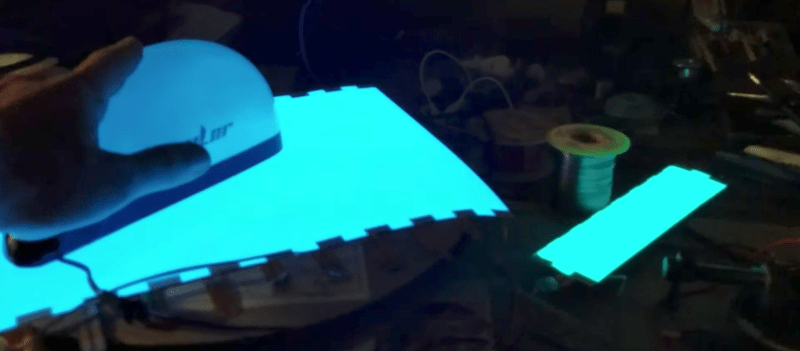[fool]’s entry in the Hackaday Prize competition is a modular and configurable lighting system the purpose of which is to assist seniors and others with limited mobility navigate safely at home. For [fool], this means the quiet steady hum of electroluminescent panels and wire. EL stuff is notoriously tricky to power, as it only operates on AC. The MoonLITE project is the answer to the problem of an easy to use EL power supply. The goal is to create a 5 watt, quiet, wearable EL power supply that outputs 100V at 100Hz.
One of the reasons why [fool] is interested in EL materials is that it can also turned into a touch sensor. This has obvious applications in lighting, and especially in assistive technologies. The MoonLITE project is based around [fool]’s Whoa Board that turns EL wires and panels into not only touch-sensitive lights, but also analog switches that can control basically anything. This unique capability of lighting doubling as a sensor offers the opportunity to make light-up EL grab bars for a senior’s bedside, for instance. He or she is going to be touching it anyway when getting up—why not add light as well as stability?
This is an especially cool project that brings something to the table we don’t really see much of. You can check out a video of the project below, complete with example of EL panels being used as buttons.




















that $75 board seems a bit pricey…
nice comment, chris!
I really like the glowing bedrail idea. Simple, clean, and futuristic.
Correction: 1000Hz, not 100Hz. Some EL stuff is designed for 60Hz (nightlights), and most for 400Hz (watch backlights), but the EL Wire and modern panels need a higher frequency to get the sort of brightness people want. (there’s a whole slew of EL backlight drivers with fixed 400Hz outputs that aren’t quite useful for most large-scale applications.) Since the glow is essentially derived from capacative losses that go up with frequency (EL stuff is essentially a lossy capacitor), brightness (and current consumption go up with frequency. I’ve always wanted to do a driver that can vary brightness by varying frequency…
(400Hz was already in use in aviation and military electronics, the initial market for expensive and exotic EL panels.)
This is something that we briefly tried, but I don’t think we got a good video of the experiment, and haven’t gotten to documenting that part of the project yet (so please do follow along if you are interested)!
The design we ultimately converged on was essentially a high voltage audio amp (that’s what you see a prototype of here: https://hackaday.io/project/26271/gallery#7136394162f8b7ecfd2a09baf409877c). We tried passing audio into it and it was pretty neat (but looks like I forgot to document it…). Basically you can hear the panel a little bit like a speaker, and you (somewhat surprisingly) get some color shift in addition to brightness shift at higher frequencies.
We’d totally consider organizing a small run of “proto boards” that let people build (and visualize) the outputs of audio circuits. The panels start losing brightness at like 1.5-2KHz, so at least a high-pass filter might help.
The most relevant piece of documentation I could find was: https://youtu.be/ydBbFrRX6D0?t=32s. In this earlier experiment, we were getting quite a bit of voltage drop as the frequency increased.
Hey, fwiw, our wires and panels hum waaaaaay less than things you might be familiar with :O.
Most of the hum associated with EL things usually comes from the power supply, which we are really trying to minimize (by boosting at a high frequency instead of relying on self-oscillating circuits where the transformer runs at ~1000Hz (and varies with the load)).
I’d like to see some details on how the touch sensing works. Also the ‘patent pending’ on the driver board.
I happen to have spoken to the inventor at a maker fair. The high-voltage AC power supply for the EL wire cycles on and off at a high speed. During the off cycle, DC logic-level circuitry comes online and uses the conductive EL material as a capacitive sensor.
As I understand it, this power supply design (along four channels, no less) is a big part of why the board costs as much as it does. I suggested to the guy that an Arduino-compatible with built-in EL drivers is compelling enough on it’s own, and that he should do a version without the touch sensing. We shall see.
Thanks for the help dahud!
To provide a bit more detail about the electronics architecture:
The board has a microprocessor (the atmega32u4), an on board EL power supply (which provides ~240V @ 700 Hz peak to peak without load), an 8 channel high voltage switch (controlled by software serial from the mirco, rated for “200v” 60Hz, removing visible flickering. For reference, a simple use case is something like: https://github.com/foolish-products/whoaboard_getstarted/blob/master/hardware/whoaboard/avr/libraries/WhoaSense/examples/ex5_trigger-on-measure/ex5_trigger-on-measure.ino#L51
If you are asking what happens during a touch operation, this is published here:
https://github.com/foolish-products/whoaboard_getstarted/blob/master/hardware/whoaboard/avr/libraries/WhoaSense/whoasense.cpp#L105
The short story is that:
1. The switches close, disconnecting the EL supply from the EL elements
2. A “measurement capacitor” is reset
3. This capacitor is then charged by a signal generated by the microprocessor (we use the “fast PWM” functionality of the 32u4 for this http://r6500.blogspot.com/2014/12/fast-pwm-on-arduino-leonardo.html), which passes by the EL element and is affected by the capacitive coupling between the EL element and the reference ground of the circuit board
4. The processor reads a voltage off of this measurement capacitor.
Happy to answer more questions if you’d like. Email works well! josh [at] foolishproducts [dot] com